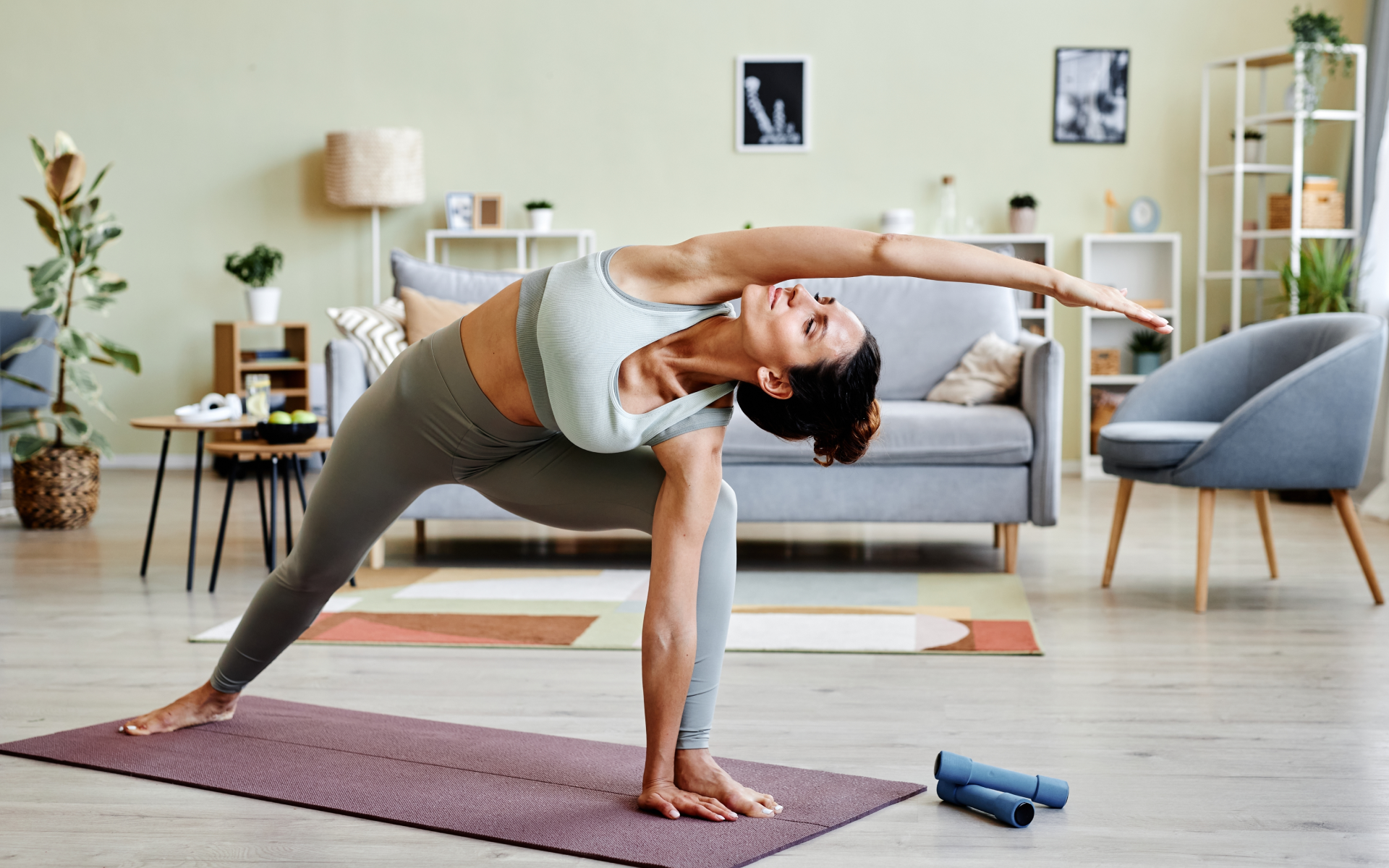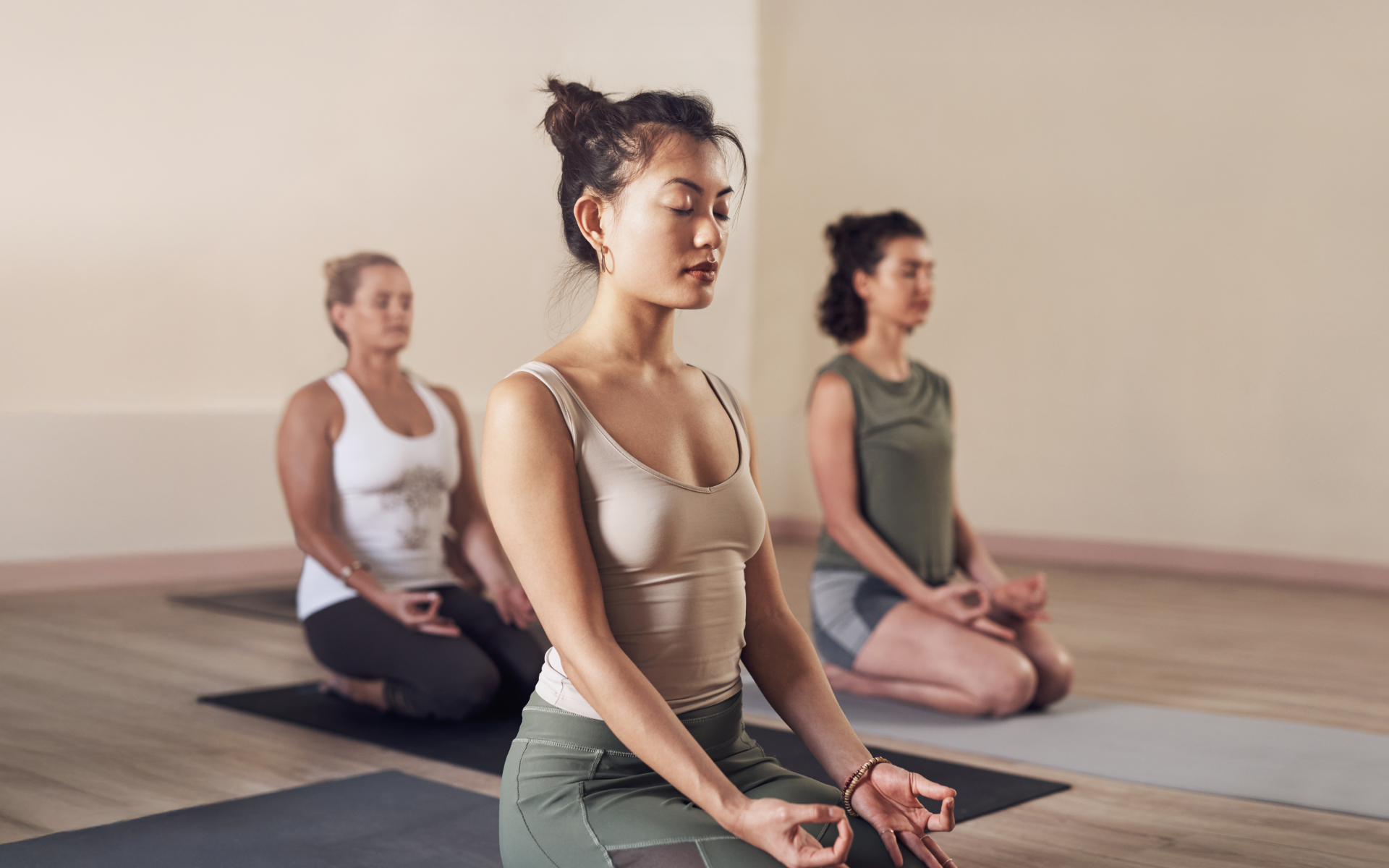Are you thinking about starting a somatic exercise program but are unsure if it’s the right fit for you? This article can help you understand what somatic exercises are and if they meet your wellness needs.
Stress is a constant companion in our daily lives (1), and finding a holistic approach to wellness has never been more important. Somatic exercises have become a popular way to reconnect with the body, release chronic pain, and enhance overall well-being (2, 3, 4). Rooted in ancient practices and psychology, somatic exercises were popularized by Thomas Hanna (5).
The term “somatic” comes from the Greek word “soma”, which means “body”, and these exercises focus on the intricate relationship between the mind and body. They offer gentle yet powerful movements that are designed to improve body awareness and promote healing from within. Whether you’re looking to alleviate discomfort, reduce stress, or simply move with more ease, somatic exercises may be the key to unlocking a healthier, more balanced you.
What Are Somatic Exercises?
Somatic exercises are a unique form of movement that places a strong emphasis on the mind-body connection. The primary goal of these exercises is to release tension, enhance body awareness, and create a better connection between body and mind. Unlike more intense forms of exercise such as high-intensity interval training (HIIT), somatic movements are gentle and typically involve slow, deliberate actions. This mindful approach helps retrain the nervous system, encouraging it to release patterns of chronic tension and pain. By focusing on how movements feel rather than how they look, somatic exercises promote a deeper understanding of your body and its signals, which leads to improved physical and mental well-being.
Which Somatic Workout Is Best?
Choosing the best somatic workout depends on your individual needs, preferences, and specific health goals. Somatic exercises can range from movement techniques to simple grounding techniques that you can easily perform at home. Here are some popular and highly effective somatic exercise programs to consider:
Feldenkrais Method
The Feldenkrais Method, which was created by Moshe Feldenkrais, is a gentle, movement-based approach that emphasizes awareness through movement (6). The method consists of two main components:
Awareness Through Movement (ATM): These are group classes where students are guided through a series of movements that are designed to improve their self-awareness and physical function. The movements are often slow and subtle, and they encourage participants to focus on the sensations and connections in their bodies.
Functional Integration (FI): This is a one-on-one, hands-on session where a trained practitioner uses gentle touch to guide the client through movements, helping them explore and refine their movement patterns.
The Feldenkrais Method is particularly beneficial for those who are recovering from injuries or dealing with chronic pain (7).
Whether you want to learn how to exit the spiral of self-harming behavior, overcome anxiety, cure insomnia or simply give yourself the time and space to bliss out and soak up the moment of complete peace and quiet – BetterMe: Meditation & Sleep app is exactly the tool for that ! If you don’t take care of number one, who will?
Alexander Technique
The Alexander Technique, which was developed by F. Matthias Alexander, is a method that focuses on unlearning harmful habits that interfere with natural movement and posture (8). It emphasizes the efficient use of the body by promoting awareness and conscious control over habitual movements.
Key aspects of the Alexander Technique include:
Self-Awareness: Learning to become aware of your body’s habitual patterns and how they affect your posture and movement.
Inhibition and Direction: Practicing the ability to stop or inhibit habitual reactions and direct the body into more efficient and less stressful patterns of movement.
Mind-Body Coordination: Improving coordination between the mind and body to enhance overall functioning.
The Alexander Technique is beneficial for improving posture, reducing pain, and enhancing performance in activities such as playing musical instruments, acting, and sports (9, 10).
Body Scan
Body scan is a somatic practice that involves systematically focusing on different parts of the body to develop greater awareness and relaxation (11, 12). It’s often used in conjunction with somatic exercises to deepen the mind-body connection. Here’s how it works:
Guided Focus: Typically, a guided practitioner will lead you through the process, instructing you to focus on each body part, starting from the toes and moving up to the head. You can also follow this practice on your own.
Sensory Awareness: As you focus on each area, without judgment, you become aware of any tension, discomfort, or sensations, which allows you to release stress and promote relaxation.
Integration: By regularly practicing body scan, you can enhance your overall somatic awareness, which makes it easier to recognize and address areas of tension or imbalance in your daily life.
Read more: Somatic Healing Techniques: A Holistic Approach to Physical and Emotional Recovery
Diaphragmatic Breathing
Diaphragmatic breathing, which is also known as deep or belly breathing, is a technique that involves fully engaging the diaphragm for more efficient and relaxed breathing. This practice is often incorporated into somatic exercise programs to improve respiratory function and reduce stress and anxiety (13, 14). Its steps include:
Breath Awareness: Start by placing one hand on your chest and the other on your abdomen. Inhale deeply through your nose, allowing your abdomen to rise while keeping your chest relatively still.
Controlled Exhalation: Exhale slowly through your mouth, feeling your abdomen fall. Focus on the movement of the diaphragm and the release of tension with each breath. Consistent practice of diaphragmatic breathing can improve oxygen exchange, reduce stress levels, and enhance the overall effectiveness of somatic exercises.
Each of these somatic exercises offers unique benefits and can be tailored to your specific needs. Whether you’re looking to alleviate chronic pain, improve your posture, or simply enhance your overall movement quality, exploring these somatic approaches can result in profound improvement to your physical and emotional well-being.
Do Somatic Exercise Programs Really Work?
Yes, somatic exercise programs have been proven to be effective in reducing pain, improving mobility, and enhancing overall well-being (15, 16). Many people report significant improvements in their physical and emotional health after consistent practice.
Is There an App for Somatic Exercises?
Yes, there are apps available that can guide you through somatic exercises. Try the BetterMe app, which offers a range of workouts including somatic exercises, to help you achieve your fitness and wellness goals.
Where Should You Start with Somatic Exercises?
Starting with somatic exercises can be simple and accessible. Here are some steps to get you started:
Research: Explore various somatic exercise methods and choose one that resonates with you. Everyone has different needs, such as managing stress or alleviating pain, so look for specific somatic exercises that address your unique requirements.
Just Dive In: Start with short sessions and gradually increase the duration as you become more comfortable with the exercises. If any exercise causes you discomfort, pause or try a different one. If pain persists, seek professional support.
Listen to Your Body: Somatic exercises emphasize a bottom-up approach, focusing on the body’s sensations to connect with the mind. Pay close attention to how your body feels during and after exercises and adjust your practice accordingly.
With stress being a constant presence in our lives, taking time to process emotions, decompress and get into the right frame of mind is absolutely crucial. With BetterMe: Meditation & Sleep app your mental health is in good hands! Start using it now !
What Is the Number 1 Somatic Exercise?
The best somatic exercise can vary from person to person, but a widely recommended starting point is pandiculation. Pandiculation involves slow, conscious movements that reset the nervous system and help regain voluntary control over muscles (17). This exercise, which is usually integrated into various somatic practices such as somatic yoga, helps release chronic tension and improve overall body awareness. This makes it an excellent foundational practice for anyone who is starting their somatic exercise journey (18). A widely recommended starting point is the Cat-Cow Stretch from the Feldenkrais Method (19). This exercise helps mobilize the spine and release tension in the back and neck.
Read more: Somatic Dance: Liberation through Expression and Movement
Yes, many somatic exercises offer a range of techniques that can be practiced independently. For example, grounding exercises and breathing techniques such as diaphragmatic breathing can be practiced at home. These practices can be integrated into daily routines to enhance the mind-body connection and support overall physical and mental well-being Somatic exercises play a vital role in addressing trauma by focusing on how it’s stored and manifested in the body. Trauma often leads to chronic physical tension and stress as the body’s response mechanisms remain activated long after the initial threat has passed (20). This tension can manifest as tight muscles, shallow breathing, and overall discomfort. Somatic exercises promote healing by encouraging relaxation and increasing body awareness. Techniques such as deep breathing, gentle movement, and mindfulness help individuals release stored tension and regulate their nervous systems. By creating a deeper connection between mind and body, somatic exercises also support emotional healing, allowing you to process and resolve the emotions that are linked to traumatic experiences more effectively Somatic workouts can range from a few minutes to an hour or more, depending on your routine and goals. It can be beneficial to start with shorter sessions and gradually increase the time Yes, many somatic exercises such as breathing techniques can be performed in bed, which makes them accessible for people with limited mobility or those who are looking for a gentle way to start their day or unwind before sleep.FAQs
Can I do somatic workouts on myself?
Do somatic exercises really release trauma?
How long are somatic workouts?
Can you do somatic exercises in bed?
The Bottom Line
Embarking on a somatic exercise journey can lead to profound improvements in your physical and mental well-being. Whether you choose to follow a structured program or integrate simple exercises into your daily routine, the key is to move mindfully and listen to your body.
DISCLAIMER:
This article is intended for general informational purposes only and does not serve to address individual circumstances. It is not a substitute for professional advice or help and should not be relied on for making any kind of decision-making. Any action taken as a direct or indirect result of the information in this article is entirely at your own risk and is your sole responsibility.
BetterMe, its content staff, and its medical advisors accept no responsibility for inaccuracies, errors, misstatements, inconsistencies, or omissions and specifically disclaim any liability, loss or risk, personal, professional or otherwise, which may be incurred as a consequence, directly or indirectly, of the use and/or application of any content.
You should always seek the advice of your physician or other qualified health provider with any questions you may have regarding a medical condition or your specific situation. Never disregard professional medical advice or delay seeking it because of BetterMe content. If you suspect or think you may have a medical emergency, call your doctor.
SOURCES:
- Stress (2023, who.int)
- Moving With Pain: What Principles From Somatic Practices Can Offer to People Living With Chronic Pain (2021, frontiersin.org)
- Pilates, mindfulness and somatic education (2013, intellectdiscover.com)
- Somatic interventions to improve self-regulation in children and adolescents (2021, onlinelibrary.wiley.com)
- Somatics: Reawakening the Mind’s Control of Movement, Flexibility, and Health (1988, books.google.lk)
- The Effectiveness of the Feldenkrais Method: A Systematic Review of the Evidence (2015, onlinelibrary.wiley.com)
- Evidence for the Effectiveness of the Feldenkrais Method (2020, journals.humankinetics.com)
- Alexander technique and Feldenkrais method: a critical overview (2004, pmr.theclinics.com)
- Randomised controlled trial of Alexander technique lessons, exercise, and massage (ATEAM) for chronic and recurrent back pain (2008, bmj.com)
- The Effects of the Alexander Technique on the Performance of Music Students (2016, encompass.eku.edu)
- Immediate effects of a brief mindfulness-based body scan on patients with chronic pain (2012, link.springer.com)
- The effects of body scan meditation: A systematic review and meta-analysis (2022, iaap-journals.onlinelibrary.wiley.com)
- Effectiveness of diaphragmatic breathing for reducing physiological and psychological stress in adults: a quantitative systematic review (2019, journals.lww.com)
- The Effectiveness of Diaphragmatic Breathing Relaxation Training for Reducing Anxiety (2016, onlinelibrary.wiley.com)
- Improving Postural Control in the Battement Tendu: One Teacher’s Reflections and Somatic Exercises (2010, tandfonline.com)
- Somatic Strength Training: An Alternative to “No Pain No Gain” (2020, liebertpub.com)
- Pandiculation: Nature’s way of maintaining the functional integrity of the myofascial system? (2011, sciencedirect.com)
- Impact of Somatic Yoga and Meditation on Fall Risk, Function, and Quality of Life for Chemotherapy-Induced Peripheral Neuropathy Syndrome in Cancer Survivors (2019, journals.sagepub.com)
- Pandiculation in Yoga: A Healthier Way to Stretch (2023, yogauonline.com)
- The Body Keeps the Score: Memory and the Evolving Psychobiology of Posttraumatic Stress (1994, journals.lww.com)










